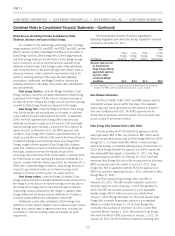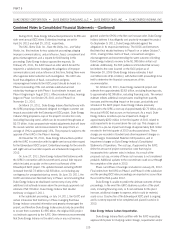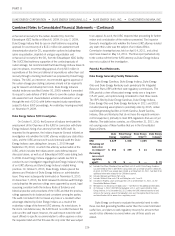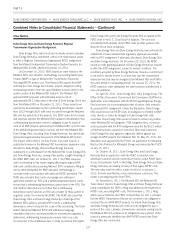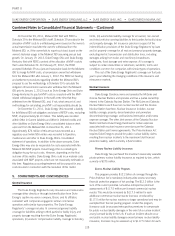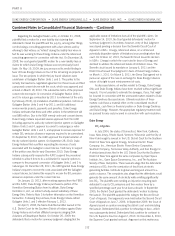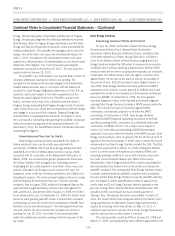Duke Energy 2011 Annual Report Download - page 150
Download and view the complete annual report
Please find page 150 of the 2011 Duke Energy annual report below. You can navigate through the pages in the report by either clicking on the pages listed below, or by using the keyword search tool below to find specific information within the annual report.
PART II
DUKE ENERGY CORPORATION •DUKE ENERGY CAROLINAS, LLC •DUKE ENERGY OHIO, INC. •DUKE ENERGY INDIANA, INC.
Combined Notes to Consolidated Financial Statements – (Continued)
well as other relevant environmental contingent liabilities.
Management, in the normal course of business, continually assesses
the nature and extent of known or potential environmental-related
contingencies and records liabilities when losses become probable
and are reasonably estimable. Costs associated with remediation
activities within the Duke Energy Registrants’ operations are typically
expensed unless regulatory recovery of the costs is deemed probable.
As of December 31, 2011, Duke Energy Ohio had a total
reserve of $28 million, related to remediation work at certain former
manufactured gas plant (MGP) sites. Duke Energy Ohio has received
an order from the PUCO to defer the costs incurred. As of
December 31, 2011, Duke Energy Ohio has deferred $69 million of
costs related to the MGP sites. The PUCO will rule on the recovery of
these costs at a future proceeding. Management believes it is
probable that additional liabilities will be incurred as work progresses
at Ohio MGP sites; however, costs associated with future remediation
cannot currently be reasonably estimated.
Clean Water Act 316(b).
The EPA published its proposed cooling water intake structures
rule on April 20, 2011. Duke Energy submitted comments on the
proposed rule on August 16, 2011. The proposed rule advances one
main approach and three alternatives. The main approach
establishes aquatic protection requirements for existing facilities and
new on-site facility additions that withdraw 2 million gallons or more
of water per day from rivers, streams, lakes, reservoirs, estuaries,
oceans, or other U.S. waters for cooling purposes. Based on the main
approach proposed, most, if not all of the 23 coal and nuclear-fueled
generating facilities in which the Duke Energy Registrants are either a
whole or partial owner are likely affected sources. Additional sources,
including some combined-cycle combustion turbine facilities, may
also be impacted, at least for intake modifications.
The EPA has plans to finalize the 316(b) rule in July 2012.
Compliance with portions of the rule could begin as early as 2015.
Because of the wide range of potential outcomes, including the other
three alternative proposals, the Duke Energy Registrants are unable to
estimate its costs to comply at this time.
Cross-State Air Pollution Rule (CSAPR).
On August 8, 2011, the final Cross-State Air Pollution Rule
(CSAPR) was published in the Federal Register. The CSAPR
established state-level annual SO2and NOxbudgets that were to take
effect on January 1, 2012, and state-level ozone-season NOxbudgets
that were to take effect on May 1, 2012, allocating emission
allowances to affected sources in each state equal to the state budget
less an allowance set-aside for new sources. The budget levels were
set to decline in 2014 for many states, including each state that the
Duke Energy Registrants operate in, except for South Carolina where
the budget levels were to remain constant. The rule allowed both
intrastate and interstate allowance trading.
Numerous petitions for review of the CSAPR and motions for
stay of the CSAPR were filed with the United States Court of Appeals
for the District of Columbia. On December 30, 2011 the court
ordered a stay of the CSAPR pending the court’s resolution of the
various petitions for review. Based on the court’s order, the EPA
continues to administer the Clean Air Interstate Rule that the Duke
Energy Registrants have been complying with since 2009 and which
was to be replaced by the CSAPR beginning in 2012. Oral
arguments in the case are scheduled for April 13, 2012, with a court
decision expected in the third quarter of 2012.
The stringency of the 2012 and 2014 CSAPR requirements
varied among the Duke Energy Registrants. Where the CSAPR
requirements were to be constraining, activities to meet the
requirements could include purchasing emission allowances, power
purchases, curtailing generation and utilizing low sulfur fuel. The
CSAPR was not expected to result in Duke Energy Registrants adding
new emission controls. Technical adjustments to the CSAPR recently
finalized by the EPA will not materially impact the Duke Energy
Registrants. The Duke Energy Registrants cannot predict the outcome
of the litigation or how it might affect the CSAPR requirements as they
apply to the Duke Energy Registrants. See Note 12 for further
information regarding impairment of emissions allowances as a result
of the CSAPR.
Coal Combustion Product (CCP) Management.
Duke Energy currently estimates that it will spend $259 million
($78 million at Duke Energy Carolinas, $63 million at Duke Energy
Ohio and $118 million at Duke Energy Indiana) over the period
2012-2016 to install synthetic caps and liners at existing and new
CCP landfills and to convert some of its CCP handling systems from
wet to dry systems to comply with current regulations. The EPA and a
number of states are considering additional regulatory measures that
will contain specific and more detailed requirements for the
management and disposal of CCPs, primarily ash, from the Duke
Energy Registrants’ coal-fired power plants. On June 21, 2010, the
EPA issued a proposal to regulate, under the Resource Conservation
and Recovery Act, coal combustion residuals (CCR), a term the EPA
uses to describe the CCPs associated with the generation of
electricity. The EPA proposal contains two regulatory options whereby
CCRs not employed in approved beneficial use applications would
either be regulated as hazardous waste or would continue to be
regulated as non-hazardous waste. Duke Energy cannot predict the
outcome of this rulemaking. However, based on the proposal, the
cost of complying with the final regulation will be material, and are
not included in the estimates discussed above. The EPA
Administrator has indicated that the Agency could issue a final rule in
late 2012.
Mercury and Air Toxics Standards (MATS).
On February 16, 2012, the final Mercury and Air Toxics
Standards rule (previously referred to as the Utility MACT Rule) was
130



